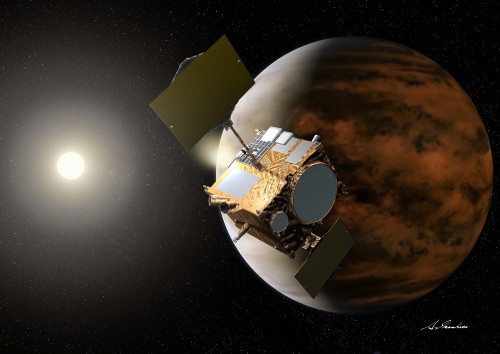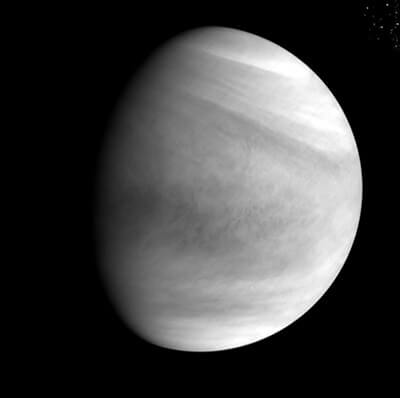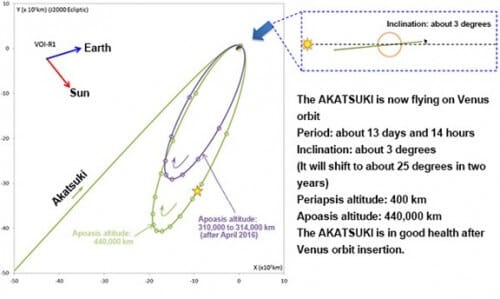After using four secondary thrusters to save the mission. Japan's space agency hopes it will now be able to fulfill most of the original mission goals, even though the original planned orbit was much closer than the current orbit

The Japanese Space Agency (JAXA) announced today that the Akatsuki ("Dawn" in Japanese) probe managed to enter orbit around the planet Venus, 5 years after it failed to do so due to a malfunction that destroyed the main engine, and after using four secondary thrusters to save the mission. Japan's space agency hopes it will now be able to fulfill most of the original mission goals, even though the original planned orbit was much closer than the current orbit.
Akatsuki was launched on May 20, 2010 from the Tengeshima Space Center, and when it arrived at the planet in December of that year, it fired its main engine to enter orbit around Venus. However, a malfunction in the valve between the helium tank and the hydrazine fuel tank of the propulsion system resulted in very high temperatures in the engine and the breaking of the "neck" of the main engine, which put it out of use. Due to the malfunction, the probe did not enter the desired orbit, and instead circled the sun. But the mission engineers did not give up, and waited 5 years until a second chance came this year.
On December 7 at 8:51 a.m. (Japan time), Akatsuki re-approached Venus, firing four secondary engines originally designed to steer the spacecraft. Although their thrust is weaker than the destroyed main engine, they were operated for a relatively long time, 20 minutes, and in addition the probe reduced its mass after discarding 65 kg of unnecessary oxidizer (because, unlike the main engine, the secondary propulsion system does not use it but only in the hydrazine fuel).
The Japanese Space Agency took two days to estimate Akatsuki's new orbit, and today the agency Has announced that the probe is now orbiting Venus in an orbit that lasts 13 days and 14 hours. The orbit is highly elliptical, and ranges from periapseide (the closest point in the orbit) of 400 km from Venus to apoapseide (the furthest point) of about 440 thousand km from Venus. This is a much higher orbit than the original orbit planned for Akatsuki (about 80,000 km at the apogee), but the agency has announced that it expects the probe to be able to achieve most of its goals despite this. In addition, in April 2016 the probe will activate the secondary propulsion system again to descend to a lower orbit, with an apoapside of about 310,000 km.

Venus as photographed by Akatsuki on December 7, 2015, from a distance of about 72,000 km
The Akatsuki probe, which means "dawn" in Japanese, became, upon entering orbit around Venus, the only probe currently exploring the planet, after the European probe Venus Express finished its mission around Venus in December 2014. NASA may send a mission to Venus as part of the "Decbury" or " its "new frontiers", but if the proposals for such a mission are accepted in a competitive framework that includes proposals for additional research goals, they will only be launched in the early twenties.
The probe is equipped with five cameras that will investigate the atmosphere of Venus in infrared and ultraviolet ranges. Among other things, the mission was designed to investigate the unique phenomenon that exists in the dense atmosphere of Venus, moving at a much higher speed than the self-rotation of Venus. The mission will also investigate the phenomena of lightning, sulfuric acid clouds and water in the upper atmosphere as well as try to locate volcanic activity on the ground.


3 תגובות
Those who see after 2020 should respond!
To this day I have not seen even one article about the spaceship and any findings. Did it stop functioning because of some malfunctions?
The next star where life will form and in a billion years they will look at the red earth from there and not understand how it was destroyed
The UN will be there and they will discuss the warming of the planet and establishing a colony on Earth